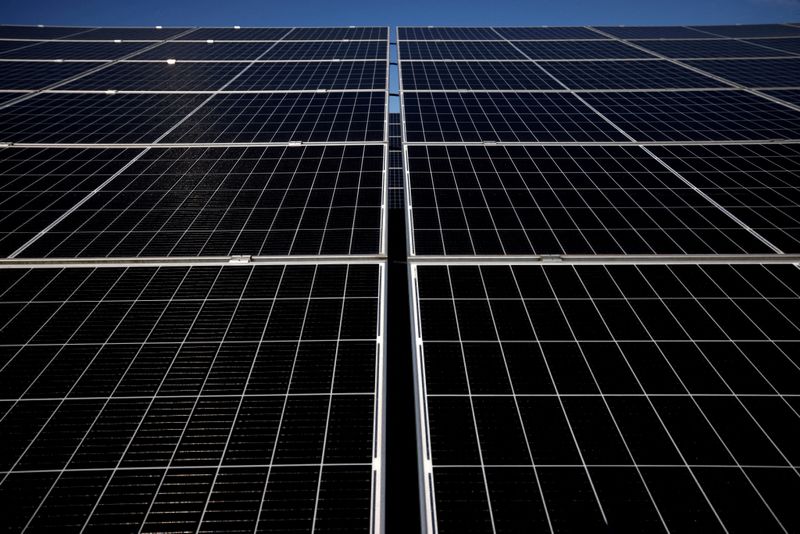By Riham Alkousaa
BERLIN (Reuters) – For months, Philip Matthias tried to persuade his father to put in photo voltaic panels on their firm’s roof within the japanese German state of Thuringia, aiming to chop electrical energy prices and carbon emissions on the steel merchandise manufacturing unit.
Initially sceptical of the two.3-million-euro ($2.5 million) funding, a considerable sum for the medium-sized Tridelta, his father crunched the numbers and determined to almost double the challenge capability, opting to put in photovoltaic modules that might energy round 900 households along with the manufacturing unit.
“The PV methods amortize after about 7-1/2 years. The producer provides a assure of 20 years. Meaning that is a particularly profitable funding,” Matthias advised Reuters.
For the reason that battle in Ukraine and the sudden drop in Russia fossil gasoline exports to Germany, Berlin has launched legal guidelines to speed up solar energy enlargement, a part of its plan to cowl 80% of the nation’s vitality from renewables by 2030.
Inspired by a feed-in tariff offering a assured value to renewable vitality producers promoting their energy, in addition to diminished photo voltaic panel prices, German corporations are more and more turning to photo voltaic to get round excessive vitality prices.
Though Germany has Europe’s largest capability of photo voltaic and wind energy technology, its small and medium-sized corporations have but to profit from decrease electrical energy costs due to excessive grid charges and taxes they have to pay. By producing their very own solar energy, they keep away from these charges and taxes.
Corporations consumed round 69% of Germany’s nationwide electrical energy in 2023, information by the BDEW utilities affiliation confirmed.
“As electrical energy costs in Germany present no indicators of lowering as beforehand anticipated, corporations are more and more recognising the financial viability of putting in photo voltaic panels,” mentioned Marie-Theres Husken, an vitality knowledgeable for the BVMW affiliation for small- and medium-sized companies.
CORPORATE SOLAR SHIFT
Newly put in photovoltaic capability on enterprise rooftops rose by 81% year-on-year within the first 4 months of the 12 months, outpacing the 1% progress within the residential sector, information by the BSW solar energy affiliation reveals.
A Might survey by pollster YouGov confirmed greater than half of German corporations with appropriate roofs deliberate to put in solar energy methods within the subsequent three years. BVMW forecasts that just about all manufacturing corporations in Germany will use photo voltaic vitality by 2030.
In response to rising demand, Germany’s largest residential solar energy developer, Enpal, mentioned in April it was increasing into the business sector.
“The demand was not as prompt… however the progress goes to be very sustainable,” Melchior Schulze Brock, CEO of business and industrial photo voltaic startup Enviria.
An April examine by the Freiburg-based Institute for Utilized Ecology confirmed there was potential to put in as much as 287 gigawatts (GW) of photo voltaic capability, greater than sufficient to fulfill Berlin’s 2030 goal of 215 GW, alongside German roads, railways, parking heaps, and industrial areas. This might considerably cut back reliance on agricultural land the place allowing and planning approvals can take as much as a decade.
A drop in photo voltaic panel costs globally since final 12 months has spurred corporations to embrace photo voltaic vitality.
“The market is overrun with low-cost however good panels from China. That implies that the system that we’re constructing now’s about 20% cheaper than a 12 months in the past,” Matthias mentioned.
A German legislative bundle handed in April easing regulation and rising subsidies for giant rooftop methods in addition to a pending tax funding reform for actual property funds working rooftop photo voltaic panels, is predicted to drive demand additional.
State feed-in subsidies for giant scale rooftop photovoltaic tasks, launched in 2021 and that are chosen through tender, have additionally boosted the pattern.
The final tender for the subsidised tasks in February noticed a 107% rise within the variety of affords year-on-year, information by the federal grid community company confirmed.
A feed-in tariff of 9.3 euros cents per kilowatt-hour, greater than Tridelta’s energy buying value, makes it at present cheaper for the corporate to promote future generated electrical energy to the grid and purchase it again, Matthias mentioned.
Germany’s economic system ministry declined to touch upon corporations’ electrical energy buying and selling methods.
“There is a excessive correlation between the feed-in tariffs and the build-up of photo voltaic PV roof high tasks,” Hugo Willink, Government Director at photo voltaic roofs developer Sunrock advised Reuters.

Sunrock, which received an order from Mercedes Benz (ETR:) in Might to construct a 23-megawatt photo voltaic challenge on the carmaker’s manufacturing unit roofs, sees Germany as its core marketplace for the approaching 12 months.
($1 = 0.9334 euros)

